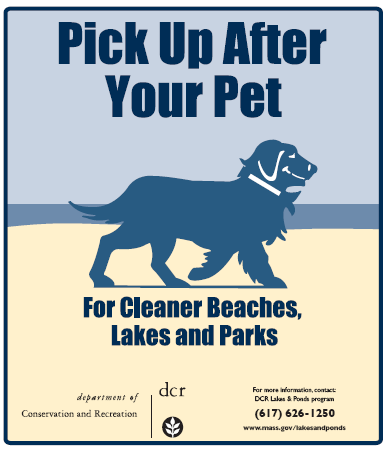Pet Waste Management

Description
Pet waste management involves using a combination of pet waste collection programs, pet awareness and education, signs, and pet waste control ordinances to alert residents to the proper disposal techniques for pet droppings. In some parts of the country, the concept of parks or portions of parks established specifically for urban dog owners has gained in popularity. With provisions for proper disposal of dog feces and siting and design to address storm water runoff, these parks may represent another option for protecting local water quality.
The presence of pet waste in storm water runoff has a number of implications for urban stream water quality, with perhaps the greatest impact from pathogens like fecal coliform. The release of nutrients from the decay of pet waste also promotes weed and algae growth in water bodies. This situation can reduce oxygen levels in the water, affecting fish and other aquatic organisms. In addition, pet waste can contribute to the spread of:
- Campylobacteriosis —a bacterial infection that causes diarrhea in humans.
- Salmonellosis—the most common bacterial infection transmitted to humans from animals. Symptoms include fever, muscle aches, headache, vomiting, and diarrhea.
- Toxocarisis—roundworms transmitted from animals to humans. Symptoms include vision loss, rash, fever, or cough.
Effectiveness
The effectiveness of pet waste collection programs has never been quantified, but in the Four Mile Run watershed in Northern Virginia, a dog population of 11,400 is estimated to contribute about 5,000 pounds of solid waste every day and has been identified as a major contributor of bacteria to the stream. Approximately 500 fecal coliform samples have been taken from Four Mile Run and its tributaries since 1990, and about 50 percent of these samples have exceeded the Virginia State water quality standard for fecal coliform bacteria (NVRC, 2001). A project is currently underway to pinpoint the source of bacterial contamination through DNA fingerprinting.
Cost
The cost of a pet waste management campaign will vary depending on several factors, including the materials produced (signs, ads, clean-up stations). The cost of signs will depend on the material used; plastics can be just as durable as and possibly cheaper than metal.
At the Mary Jane Roe Dog Park in the town of Clifton Park, New York, $700 was spent to install a 500-gallon sealed underground septic tank for pet waste. Each pet owner is charged $20 for a permit to use the dog park. Funds from the permit fees will be used to help offset the costs of the septic system (Kemper, 2000).
Options for a Pet Waste Removal Program
Pet waste removal programs can be created to include both public and private pet waste disposal.
1. Individual dog owners, specifically breeders, can be encouraged to pick up after their dogs on their own lawns and dispose of the waste either in the trash or in some cases flushing it down the toilet. Plastic baggies to can be provided through dispensers such as Mutt-Mitt stations, to encourage pick-up of waste. Individuals can also utilize various waste disposal products like Doggie Dooleys (miniature septic tanks for pet waste) or dog waste disposal units.
2. "Pooper-scooper" ordinances to regulate pet waste cleanup. These ordinances require the removal and proper disposal of pet waste from public areas and other peoples property before the dog owner leaves the immediate area.
3. Signs in public parks and the provision of receptacles for pet waste also encourage cleanup.
4. Public education programs involve pet waste messages that are incorporated into a larger non-point source message relaying the effects of pollution on local water quality using brochures and public service announcements.
Specially designated dog parks where pets are allowed off-leash. These parks typically include signs reminding pet owners to remove waste, as well as other disposal options for pet owners:
- Doggy loos: These disposal units are installed in the ground and decomposition occurs within the unit. Minimal maintenance is required (no refuse collection).
- Pooch patch: A pole is placed in the park surrounded by a light scattering of sand. Owners are encouraged to introduce their dog to the pole on entry to the park. Dogs then return to the patch to defecate and special bins are provided in which owners then place the deposit.
- The "Long Grass Principle": Dogs are attracted to long grass for defecating and areas that are mowed less frequently can be provided for feces to disintegrate naturally. A height of around 10 cm is appropriate.
References
Kemper, J. 2000. Septic Systems for Dogs? Nonpoint Source News-Notes 63. NJDEP. Pet Waste: Dealing with a Real Problem in Suburbia. New Jersey Department of Environmental Protection.
http://www.state.nj.us/dep/watershedmgt/pet_waste_fredk.htm .
Schueler, T. Stormwater Manager’s Resource Center. Center for Watershed Protection, Inc. Accessed 3/7/2002.
http://www.stormwatercenter.net .
USEPA. 1993. Guidance Specifying Management Measures for Sources of Nonpoint Pollution in Coastal Waters. U.S. Environmental Protection Agency, Office of Water, Washington, DC.
USEPA. 2002. National Menu of Best Management Practices for Storm Water Phase II. Accessed 3/7/2002.
http://www.epa.gov/npdes/menuofbmps/menu.htm .
Northern Virginia Regional Commission (NVRC). 2001. Welcome to NVRC’S Four Mile Run Program.
http://www.novaregion.org/fourmilerun.htm . Last updated April 19, 2001. Accessed June 4, 2001.
Recommended Fact Sheets and Resources
U.S.EPA. Long Island Sound Study. Pet Waste Poster. Retrieved February 19,2001,
http://longislandsoundstudy.net/wp-content/uploads/2010/03/liss_runoff.pdf
USEPA. 2001. Source Water Protection Practices Bulletin: Managing Pet and Wildlife Waste to Prevent Contamination of Drinking Water. EPA 916-F-01-027.
Link